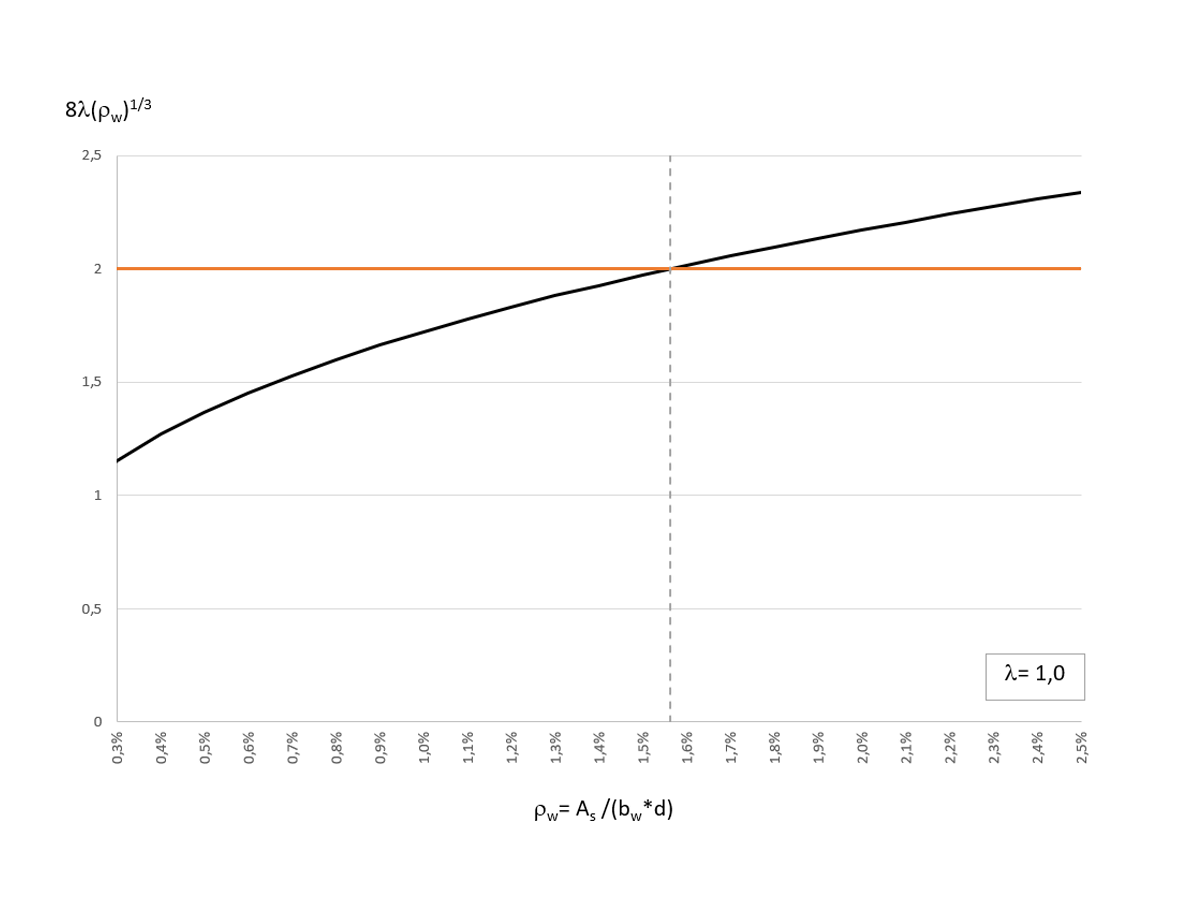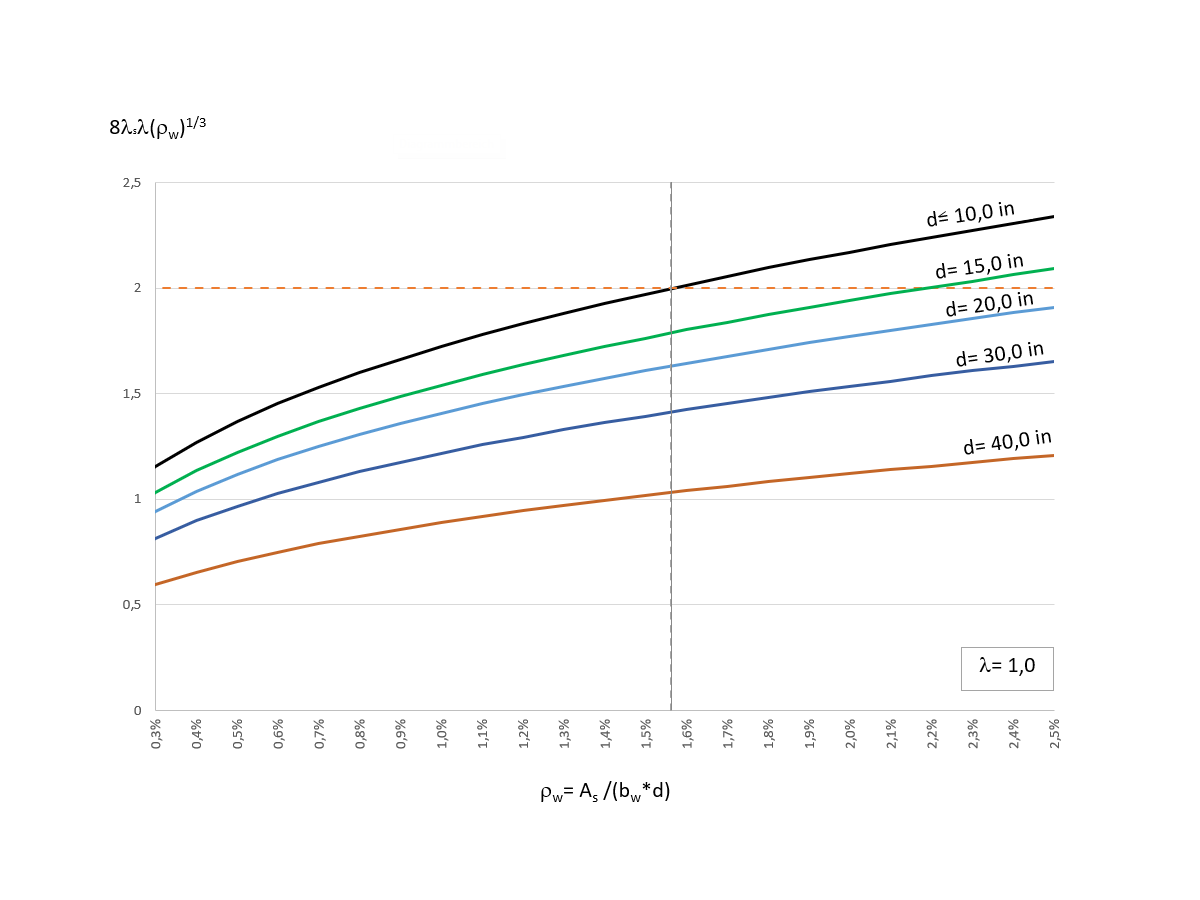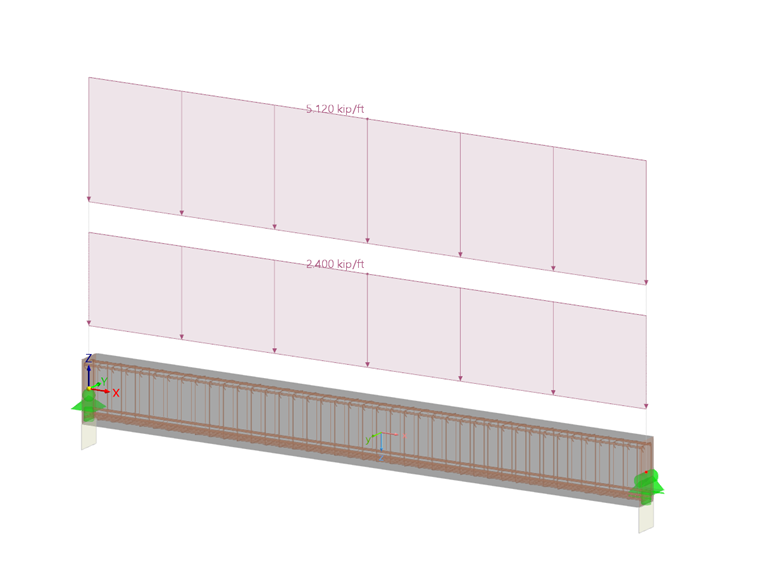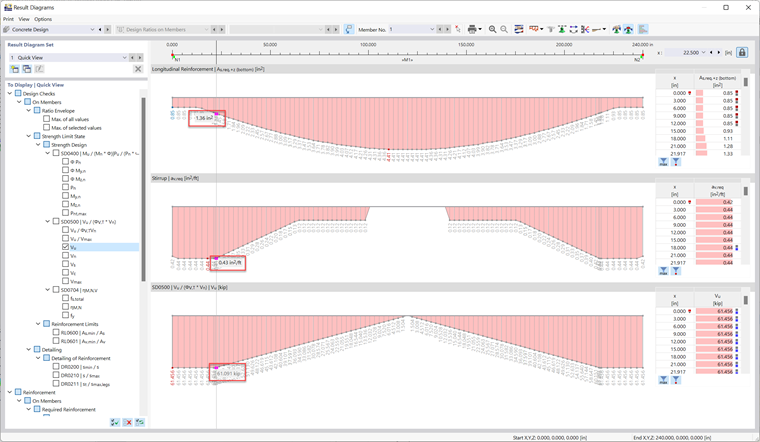Introduction
In the previous standard ACI 318-14 [2], eight equations are specified for the calculation of the shear strength Vc – without considering the application limits. The user can choose between a simplified and an exact calculation method. One of the objectives of the new concept in ACI 318-19 was to reduce the design equations for Vc. Furthermore, the concept should consider the influence of the component height, the longitudinal reinforcement ratio, and the normal stress.
Shear Resistance Vc According to ACI 318-19
For non-prestressed reinforced concrete beams, the shear resistance Vc is calculated according to ACI 318-19 [1] with Equations a) to c) from Table 22.5.5.1. With the new Equations b) and c), the member height, the longitudinal reinforcement ratio, and the normal stress now influence the shear strength, Vc. Equation a) was basically taken from ACI 318-14 [2].
The determination of the shear resistance Vc according to Table 22.5.5.1 [1], depends on the inserted shear reinforcement Av. If the minimum shear reinforcement Av,min according to 9.6.3.4 is available or exceeded, the calculation of Vc may be performed either according to Equation a)
or Equation b)
from Table 22.5.5.1 [1].
If you compare the two equations shown above, you can see that in Equation b), the factor 2 λ has been replaced by the term 8 λ (ρw)1/3. The longitudinal reinforcement ratio ρw influences the calculation of the shear resistance Vc. Image 01 shows the distribution of 8 λ (ρw)1/3 as a function of ρw (with λ = 1).
For λ = 1.0, 8 λ (ρw)1/3 becomes equal to the value 2 λ for a longitudinal reinforcement ratio ρw = 1.56%. When calculating Vc, Equation a) for λ= 1 and a longitudinal reinforcement ratio ρw (greater than) 1.56% and Equation b) for λ= 1 and ρw > 1.56% results in the greater concrete shear resistance. The standard allows the application of both equations. Therefore, the maximum value from Equations a) and b) can be used for a cost-effective design.
For beams with shear reinforcement Av less than Av,min, Equation c) of Table 22.5.5.1 [1] is to be used according to ACI 318-19 [1].
Except for variable λs, Equation c) is similar to Equation b) discussed above. For structural components with little or no shear reinforcement, the concrete shear resistance Vc decreases with increasing structural component height. By introducing the factor λs, the "Size Effect" is taken into account. The factor λs is determined according to Equation 22.5.5.1.3 [1] as follows.
The reduction of the shear resistance Vc,c by the factor λs is only effective for structural heights d (greater than) 10in. Image 02 shows the distribution of term 8 λs λ (ρw)1/3 for the different effective depths d.
Example: Calculate Required Shear Reinforcement According to ACI 318-19
The following section describes how to determine the required shear reinforcement according to the new concept of ACI 318-19 [1] for a reinforced concrete beam, which was designed in a previous Knowledge Base Article according to ACI 318-14 [2]. Image 03 shows the structural model and the design load.
The rectangular cross-section has the dimensions 25 in. · 11 in. The concrete has a compressive strength of f'c = 5,000 psi. The yield strength of the reinforcing steel used is fy = 60,000 psi. The effective depth of the tension reinforcement is applied with d = 22.5 in. The design value of the acting shear force Vu at a distance d from the support is 61.10 kips.
The determination of the shear resistance Vs according to Table 22.5.5.1 [1] depends on the height of the inserted shear reinforcement Av. The prerequisite for using Equations a) and b) is that the minimum shear reinforcement according to 9.6.3.4 [1] is applied. For this reason, a check is performed in the first step as to whether a minimum reinforcement has to be considered according to 9.6.3.1 [1].
61.10 kips > 13.13 kips
This requires a minimum shear reinforcement. This is calculated according to 9.6.3.4 [1], as follows.
av,min = 0.12 in²/ft
When considering the minimum shear reinforcement, the concrete shear resistance Vc can now be determined with Equations a) or b) of Table 22.5.5.1 [1]. The shear resistance Vc,a according to Equation a) is calculated as Vc,a = 35.0 kips. To apply Equation b), it is necessary to know the longitudinal reinforcement ratio ρw. To be able to compare the calculated shear reinforcement with the calculation result of the Concrete Design Add-on, ρw is determined with the required longitudinal reinforcement at the distance d from the support. A bending moment of My,u = 1533 kip-in results in a longitudinal reinforcement of As,req = 1.33 in², which is ρw = 0.536%. Image 01 shows the influence of the longitudinal reinforcement ratio ρw on the calculation of Vc,b. Since ρw (less than) 1.5% here, Equation b) will result in a lower shear resistance Vc,b than Equation a) and we can skip determining Vc,b. However, we calculate Vc,b to show it.
Vc,b = 24.52 kips
As expected, Equation b) provides a lower shear resistance than Equation a).
Additionally, the shear resistance Vc is limited to the maximum value Vc,max according to 22.5.5.1.1 [1].
av,min = 0.12 in²/ft
When considering the minimum shear reinforcement, the concrete shear resistance Vc can now be determined with Equations a) or b) of Table 22.5.5.1 [1].
The shear resistance Vc,a according to Equation a) is calculated as Vc,a = 35.0 kips.
To apply Equation b), it is necessary to know the longitudinal reinforcement ratio ρw. To be able to compare the calculated shear reinforcement with the calculation result of the Concrete Design Add-on, ρw is determined with the required longitudinal reinforcement at the distance d from the support. A bending moment of My,u = 1533 kip-in results in a longitudinal reinforcement of As,req = 1.33 in², which is ρw = 0.536%. Image 01 shows the influence of the longitudinal reinforcement ratio ρw on the calculation of Vc,b. Since ρw (greater than) 1.5% here, Equation b) will result in a lower shear resistance Vc,b than Equation a) and we can skip determining Vc,b. However, we calculate Vc,b to show it.
Vc,b = 24.52 kips
As expected, Equation b) provides a lower shear resistance than Equation a).
Additionally, the shear resistance Vc is limited to the maximum value Vc,max according to 22.5.5.1.1 [1].
Vc,max = 87.5 kips
Finally, the calculation of the required shear reinforcement results in the following applicable concrete shear force resistance Vc.
Vc = max [Vc,a; Vc,b ] ≤ Vc,max
Vc = [35.0 kips; 24.5 kips] ≤ 87.5 kips
Vc = 35.0 kips
The required shear reinforcement req. av is calculated as follows:
Req. av = 0.41 in²/ft ≥ 0.12 in2/ft
The reinforced concrete design according to ACI 318-19 [1] can be performed with RFEM 6. The Concrete Design Add-on also calculates a required shear reinforcement of 0.43 in²/ft at the distance d from the support (see Image 04).
Note: The results in RFEM 6 differ from the hand calculations slightly due to a more accurate value for the Depth (d) calculated. RFEM 6 takes into account that there are multiple layers of tension reinforcement where the hand calculations assume a single layer.
Finally, the maximum load capacity of the concrete compression strut of the shear truss is verified according to Section 22.5.1.2.
61.10 kips ≤ 175.00 kips.
The shear design according to ACI 318-19 is fulfilled.
As expected, Equation b) provides a lower shear resistance than Equation a).
Additionally, the shear resistance Vc is limited to the maximum value Vc,max according to 22.5.5.1.1 [1].
Summary
ACI 318-19 [1] introduced a new concept to determine the shear resistance Vc. It was possible to reduce the number of potential design equations from the previous version to three equations while taking into account the influence of the normal stress, the component height, and the longitudinal reinforcement ratio. This simplifies the calculation of the shear resistance Vc.
,_Table_22.5.5.1,_ACI_318-19.png?mw=760&hash=df344c4cbc6e75e1a5d3e8fc97af7028acef3a2d)
,_Table_22.5.5.1_ACI_318-19.png?mw=760&hash=52b0cc2b9521511642861a07ad54c936a9837db3)


